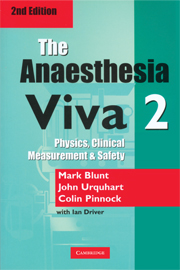Book contents
- Frontmatter
- Foreword to the First Edition
- Preface to the Second Editions
- Contents
- Physics, Clinical Measurement & Safety
- Clinical Anaesthesia
- Example 1
- Example 2
- 6 Example 3
- 7 Example 4
- Example 5
- Example 6
- Example 7
- Example 8
- Example 9
- Example 10
- Example 11
- Example 12
- Example 13
- Example 14
- Appendix 1
- Appendix 2
- Index
Example 11
Published online by Cambridge University Press: 05 February 2015
- Frontmatter
- Foreword to the First Edition
- Preface to the Second Editions
- Contents
- Physics, Clinical Measurement & Safety
- Clinical Anaesthesia
- Example 1
- Example 2
- 6 Example 3
- 7 Example 4
- Example 5
- Example 6
- Example 7
- Example 8
- Example 9
- Example 10
- Example 11
- Example 12
- Example 13
- Example 14
- Appendix 1
- Appendix 2
- Index
Summary
Scenario
The first patient on your gynaecology list, scheduled for a total abdominal hysterectomy, tells you that when she had her gall bladder out she was told ‘They had trouble getting the tube in’. How would you assess her airway?
Although many practitioners would use an LMA, assume you are being directed towards an assessment of intubating conditions – unless told otherwise by the examiner.
Clinical assessment of the airway is essential. Start with gross observations (Fat neck? No chin?). In the Mallampati scoring system the patient sits opposite the anaesthetist with mouth open and tongue protruded. The structures visible at the back of the mouth are noted (Mallampati 1985) as described below.
▪ Class 1 − Faucial pillars, soft palate and uvula visible
▪ Class 2 − Faucial pillars and soft palate visible, uvula masked by base of tongue
▪ Class 3 − Only soft palate visible
▪ Class 4 − Soft palate not visible
The modified Mallampati classification produces a high incidence of false positives. If the thyromental distance with the neck extended is less than 6.5 cm or the width of three fingers, difficult intubation is predicted. A thyromental distance of less than 6.5 cm and Mallampati class 3 or 4 predicts 80% of difficult intubations.
The Wilson risk factors may provide additional predictive information on the airway. The Wilson risk factors each score 0−2 points, to give a maximum of 10 points. A score > 2 predicts 75% of difficult intubations, also with a high incidence of false positives.
- Type
- Chapter
- Information
- The Anaesthesia Viva , pp. 116 - 119Publisher: Cambridge University PressPrint publication year: 2003



